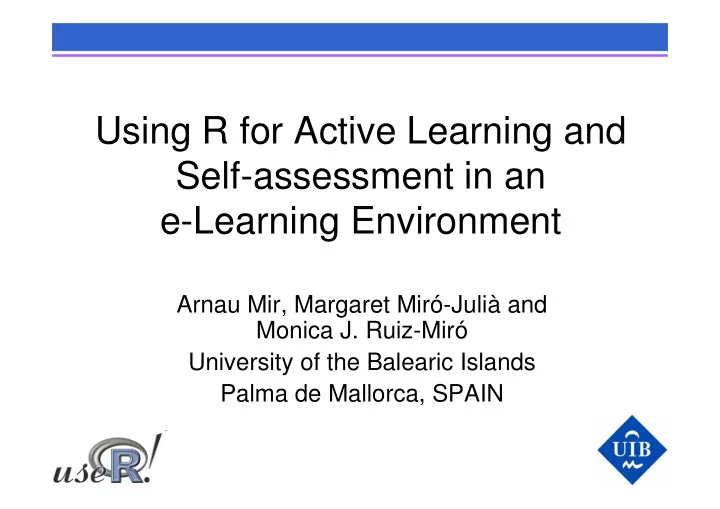

Using R for Active Learning and Self-assessment in an e-Learning Environment Arnau Mir, Margaret Miró-Julià and Monica J. Ruiz-Miró University of the Balearic Islands Palma de Mallorca, SPAIN
Using R for Active Learning and Self-assessment in an e-Learning Environment The Bologna Process The Bologna Process is a series of changes being implemented in Europe to restructure tertiary education by 2010 • European agreement initiated in 1999 (29 countries) • So far 47 countries have signed • Created a European Higher Education Area (EHEA) • Purpose of fostering increased mobility of students and graduates throughout Europe • Making academic degree standards and quality assurance standards more comparable and compatible throughout Europe Arnau Mir, Margaret Miró-Julià and Monica J. Ruiz-Miró
Using R for Active Learning and Self-assessment in an e-Learning Environment European Higher Education Area • Main points – Increase attractiveness and transparency of HE; – Increase mobility of students and professors throughout Europe; – Facilitate recognition, comparable and compatible degree structures; – Reform degree system, standardized European credit transfer system (ECTS); – Quality assurance, common guidelines and standards in quality assurance HE; – Adapt HE to labor market Arnau Mir, Margaret Miró-Julià and Monica J. Ruiz-Miró
Using R for Active Learning and Self-assessment in an e-Learning Environment European Higher Education Area • Redefinition of the teacher’s role: – Use of new teaching methodologies: basic skills are mastered while developing conceptual thinking and modeling skills – Use of innovative learning strategies: IT technologies • Redefinition of the student’s role: – From mere recipients of knowledge to active learners – Improving student’s learning process: lifelong learning Arnau Mir, Margaret Miró-Julià and Monica J. Ruiz-Miró
Using R for Active Learning and Self-assessment in an e-Learning Environment The challenge • Teach Math to Biology and Biochemistry majors Math 20100 Math 20104 6 ECTS 6 ECTS Algebra, calculus Statistics (including diff eq) (CI, HT, MLR) • Provide 150 h of student work without increasing professor’s workload Arnau Mir, Margaret Miró-Julià and Monica J. Ruiz-Miró
Using R for Active Learning and Self-assessment in an e-Learning Environment The project Students Mathematics in Science - are no longer the people our educational - common language system was designed to teach - aids formulation, analysis and - significant social changes due to solution of practical problems technological explosion PROJECT GOAL: mastery of basic skills while developing conceptual thinking and modeling skills using software that improves mathematical and statistical education and provides self-assessment teaching methodologies innovative learning An e-learning tool: R-QUEST - tries out new forms of active learning - where students discover, process and apply information - in problem solving activities - that explores the learning process - and uses self-assessed methods Arnau Mir, Margaret Miró-Julià and Monica J. Ruiz-Miró
Using R for Active Learning and Self-assessment in an e-Learning Environment R-QUEST • We want students take a more active role in their leaning process • Student’s performance is driven by assessment, introduce new assessment methods • By using IT technologies: virtual learning environments (Moodle) • R-QUEST is an autonomous system based on self-assessment methods that guide the student throughout the learning process of the R statistical package Arnau Mir, Margaret Miró-Julià and Monica J. Ruiz-Miró
Using R for Active Learning and Self-assessment in an e-Learning Environment How does R-QUEST works? • Weekly lessons are devoted to a single topic that is related to a regular classroom topic • These lessons consider one or two problems that must be solved using R • To help students learn R, handouts of required commands are available on-line together with quizzes to allow students to practice • The “standard” student has to devote 1.5 hours each week to learn R Arnau Mir, Margaret Miró-Julià and Monica J. Ruiz-Miró
Using R for Active Learning and Self-assessment in an e-Learning Environment How does R-QUEST works? • The number of questions for each quiz varies from 2 to 9, a typical quiz has 5 questions • Each question has between 10 and 15 variants that are randomly assigned each time the quiz is open by the student • The quizzes are adaptive in the sense that questions can be answered until the correct answer is found • To motivate the students, they count as a small percentage in their final grade Arnau Mir, Margaret Miró-Julià and Monica J. Ruiz-Miró
Using R for Active Learning and Self-assessment in an e-Learning Environment Technical aspects of R-QUEST • Questions are written in LaTeX • LaTeX questions are transformed into a Moodle quiz format using GIFT • A program in phython has been designed • python was chosen due to its quality and productivity Arnau Mir, Margaret Miró-Julià and Monica J. Ruiz-Miró
Using R for Active Learning and Self-assessment in an e-Learning Environment Conclusions • The R-QUEST methodology makes learning R an easy chore • R-QUEST can be used by the students in an autonomous manner, student’s are aware of their progress • R-QUEST helps the students to better understand topics related to Math and Statistics • The academic results support the usefulness of the method • The results encourage us to continue working in improving the method Arnau Mir, Margaret Miró-Julià and Monica J. Ruiz-Miró
Using R for Active Learning and Self-assessment in an e-Learning Environment THANK YOU for your attention! Any questions? Arnau Mir, Margaret Miró-Julià and Monica J. Ruiz-Miró
Recommend
More recommend